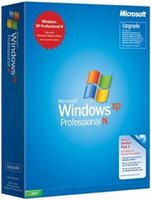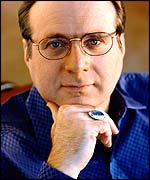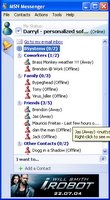I got this article on the Web(www.news.yahoo.com) and have reproduced it without any changes. So all the views expressed over here are solely that of the author.
Michael Desmond writes about technology from his home in Colchester, Vermont. He writes :
Unless you've been living under a rock for the past few months, you probably know that the latest version of Windows--called Vista--is due to hit store shelves later this year (in time for the holidays, Microsoft tells us). The successor to
Windows XP offers a little something for everyone, from eye-catching graphics and new bundled applications to more-rigorous security. In fact, there is so much in the new operating system that it can be tough to get a handle on it all.
ADVERTISEMENT
I've been noodling around with a recent beta version of Windows Vista (Build 5270) and had a chance to make some observations. While the sleek new look and polished interface caught my eye, it's what's under the covers that impressed me most. Microsoft's done a great job of improving security across the board. Things like Windows and spyware library updates are streamlined, and I definitely appreciate the more robust Backup software.
Still, there's plenty of unfinished work left to do. Internet Explorer 7 struggled to properly render some Web pages, and I found local network connectivity to be a hit-or-miss affair. And then there's the stuff that isn't even in there yet--like the intriguing Windows Sidebar, which will put real-time weather info, stock quotes, system status, RSS feeds, and other information on the display.
So during my time with Windows Vista, I kept an eye out for the reasons I--and you--might ultimately want to lay my hands on the new OS when it's available. And frankly, if you buy a new Windows-based PC at the end of this year or any time in, say, the next five years, you'll probably end up with Vista by default.
Keep in mind, this is based solely on my experience with prerelease software (and a whole new beta could be out by the time you read this). Features get tweaked, they come and go, but from what we can tell, Vista is now starting to harden into the product that will be running many, many desktops for the foreseeable future. And by and large, that's a good thing.
Here's what to be excited about:
1. Security, security, security: Windows XP Service Pack 2 patched a lot of holes, but Vista takes security to the next level. There are literally too many changes to list here, from the bidirectional software firewall that monitors inbound and outbound traffic to Windows Services Hardening, which prevents obscure background processes from being hijacked and changing your system. There's also full-disk encryption, which prevents thieves from accessing your data, even if they steal the PC out from under your nose.
Perhaps most crucial (and least sexy) is the long-overdue User Account Protection, which invokes administrator privileges as needed, such as during driver updates or software installations. UAP makes it much more convenient for users to operate Vista with limited rights (meaning the system won't let them do certain things, like load software, without clearance from an administrator). This in turn limits the ability of malware to hose your system.
2. Internet Explorer 7: IE gets a much-needed, Firefox-inspired makeover, complete with tabbed pages and better privacy management. There's also the color-coded Address Bar that lets you know if a page is secured by a digital key, or, thanks to new antiphishing features, if it's a phony Web site just looking to steal information about you.
These features will all be available for Windows XP users who download IE7. But Vista users get an important extra level of protection: IE7 on Vista will run in what Microsoft calls "protected mode"--a limited-rights mode that prevents third-party code from reaching your system. It's about darn time.
3. Righteous eye candy: For the first time, Microsoft is building high-end graphics effects into Windows. The touted Aero Glass interface features visually engaging 3D rendering, animation, and transparencies. Translucent icons, program windows, and other elements not only look cool, they add depth and context to the interface. For example, hover your cursor over minimized programs that rest on the taskbar and you'll be able to see real-time previews of what's running in each window without opening them full-screen. Now you can see what's going on behind the scenes, albeit at a cost: You need powerful graphics hardware and a robust system to manage all the effects.
4. Desktop search: Microsoft has been getting its lunch handed to it by Google and Yahoo on the desktop, but Vista could change all that. The new OS tightly integrates instant desktop search, doing away with the glacially slow and inadequate search function in XP. Powerful indexing and user-assignable metadata make searching for all kinds of data--including files, e-mails, and Web content--a lot easier. And if you're running Vista on a Windows Longhorn network, you can perform searches across the network to other PCs.
5. Better updates: Vista does away with using Internet Explorer to access Windows Update, instead utilizing a new application to handle the chore of keeping your system patched and up-to-date. The result is quicker response and a more tightly streamlined process. The update-tracking mechanism, for instance, is much quicker to display information about your installation. And now key components, such as the Windows Defender antispyware module, get their updates through this central point. Like other housekeeping features, a better Windows Update isn't a gee-whiz upgrade, but it should make it easier--and more pleasant--to keep your PC secure.
6. More media: Over the years, one of the key reasons to upgrade versions of Windows has been the free stuff Gates and Company toss into the new OS, and Vista is no exception. Windows Media Player (perhaps my least favorite application of all time) gets a welcome update that turns the once-bloated player into an effective MP3 library. The Windows Photo Gallery finally adds competent photo-library-management functionality to Windows, so you can organize photos; apply metatags, titles, and ratings; and do things like light editing and printing. The DVD Maker application, which was still very rough when I looked at it, promises to add moviemaking capabilities--along the lines of Movie Maker--to the operating system. There are even some nice new games tucked into the bundle.
7. Parental controls: Families, schools, and libraries will appreciate the tuned-up parental controls, which let you limit access in a variety of ways. Web filtering can block specific sites, screen out objectionable content by selected type, and lock out file downloads. You can also restrict each account's access by time of day or day of the week. As a dad, I can tell you this will be great for keeping kids off the PC while you're at work, for instance. You can even block access to games based on their Entertainment Software Rating Board ratings.
8. Better backups: When Windows 95 first came out, the typical hard disk was, maybe, 300MB in size. Today, desktops routinely ship with 300GB or 400GB hard drives. And yet, the built-in data-backup software in Windows has changed little in the past decade. Windows Vista boasts a much-improved backup program that should help users avoid wholesale digital meltdowns. Microsoft also tweaked the useful System Restore feature--which takes snapshots of your system state so you can recover from a nasty infection or botched software installation.
9. Peer-to-peer collaboration: The Windows Collaboration module uses peer-to-peer technology to let Vista users work together in a shared workspace. You can form ad hoc workgroups and then jointly work on documents, present applications, and pass messages. You can even post "handouts" for others to review.
10. Quick setup: Beta code alert: There are some Vista features I hope dearly for even though they haven't been built yet. This is one of them. Jim Allchin, Microsoft's co-president, says that Windows Vista boasts a re-engineered install routine, which will slash setup times from about an hour to as little as 15 minutes. Hurray! The new code wasn't in the beta version of Vista that Microsoft sent to me--my aging rig took well over an hour to set up--so I'll believe it when I see it. Still, any improvement in this area is welcome.
Five Things That Will Give You Pause
All this is not to say that Vista is a slam-dunk and everyone should be running out to buy it as soon as Microsoft takes the wraps off. Heck, Windows XP has developed into a fairly stable, increasingly secure OS. Why mess with that?
Yes, during my time with Vista, I've found more than enough features to get excited about--features that will make a sizable chunk of Windows users want to upgrade. So why would anyone in their right mind stick with what they've got? Here are a few reasons:
Pay that piper: Vista is an operating system. It's the stuff your applications run on. But it'll cost $100 or more to make the switch. Unless you're buying a new PC and starting from scratch, you may be better off saving the money for something else.
Where's my antivirus?: For all the hype about security in Windows Vista, users may be disappointed to learn that antivirus software will not be part of the package. There's every indication that an online subscription service--possibly under the OneCare rubric--will offer antivirus protection to Vista users down the road. But for the time being, you'll need to turn to third-party companies like Symantec, McAfee, Grisoft, and others for virus protection.
Watch that hourglass: Vista is a power hog. Unless you have a top-end PC with high-end graphics hardware, for instance, you won't see one of the coolest parts of the new OS--the Aero Glass interface. Microsoft did the smart thing by offering Aero Basic and Windows Classic looks as well, which will let older and slower PCs run Vista. It just won't look as pretty.
Curse the learning curve: Microsoft has already ditched some aggressive ideas--such as the whole "virtual folders" thing--because the concepts proved too confusing for users. Even so, you'll find that the new Windows changes a lot of old tricks, and not always for the better. Heck, it took me almost five minutes to find the Run command, which used to show up right in the Start menu. And many users may struggle with the new power scheme, which defaults to putting the PC into hibernation rather than shutting down. I know it frustrated me the first time I wanted to power down the system to swap out a disk drive.
Meet the old boss, same as the new boss: Microsoft has added lots of new stuff to Vista, but some features are just warmed-over fare. Windows Mail is nothing more than a rebranded Outlook Express, and Windows Defender is simply an updated version of Microsoft AntiSpyware.
So keep your eyes peeled for future previews of Vista. It may not be perfect (what software is?), but in a lot of ways, it's a giant leap forward.
My turn: Hope this helps you!















